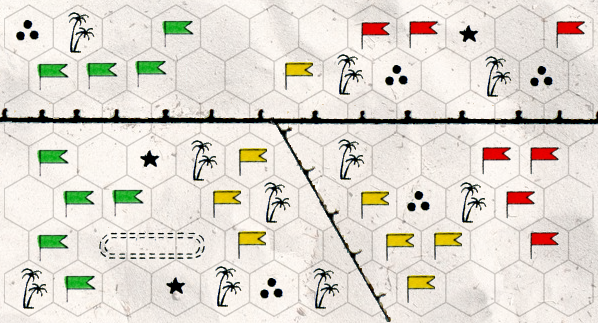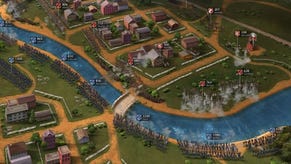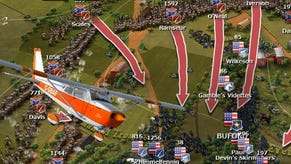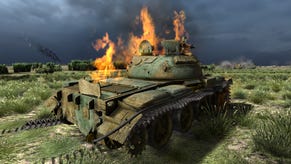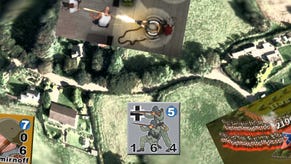The Flare Path: Gettysburg Addressed
Simulation & wargame blather
I've just started developing a tac-level WW2 wargame in which player-controlled soldiers soldier, barter for food, trip over brambles, lose keepsakes, and occasionally give away their positions by sneezing. Success is measured in souvenir Lugers. There are 338 distinct psychological states, 470 different orders, and 55 different things a man can utter after stopping a shell splinter with a buttock. It is, without doubt, the world's most exciting work-in-progress wargame. Sadly, RPS self-promotion rules and debilitating modesty mean an interview with the dev is out of the question, so this week in Flare Path you'll just have to make do with an interview with Nick 'DarthMod' Thomadis, the man behind Ultimate General: Gettysburg, the world's second most exciting work-in-progress wargame.
RPS: Most people reading this will be aware of your Total War mod work. Is that where your fascination with AI began?
Nick: Indeed, when I started to play the first Total War game (Shogun: Total War) I started to get interested in how the gameplay and the AI for games work and particularly those of the strategy genre. I was thrilled to be in control of thousands of soldiers and I wanted to make this experience as realistic and spectacular as possible for myself. So naturally, I started to research ways to do that - to reverse engineer the game, to mod that is.
RPS: In your opinion, what does the vanilla TW AI do well? What does it do badly?
Nick: Vanilla AI used to work more than sufficiently in the first games, Shogun: Total War and Medieval: Total War, at least compared to other games of those times. I remember I liked playing custom Bridge Battles a lot and then the AI was playing well, kept reserves and acted sanely around the bridge.
I noticed that from Rome: Total War and onwards, the AI was starting to behave quite badly. The overall graphics and sound improvements were of course astonishing but the AI seemed confused. It looked to me like it was rush-designed or it was a secondary priority. Particularly for the bridge battles, it was a mess: the AI always merged into a blob and that was evidence that something was not working right.
Rome: Total War’s bad battle AI literally forced me to mod in order to enjoy the game and that was the time I started to become very active on forums, sharing my modding work and collaborating with other modders.
So in short, Vanilla Battle AI does not work for me without mods, although it obviously has enormous potential. Creative Assembly Battle AI, in my opinion, has a very good code base. I never had access to the majority of parameters that affect AI to know this for sure, but I always sensed it has been a very complex engineering craft from Creative Assembly programmers. I believe that very few real time strategy games can offer the complex AI base that Total War games have, but in the end, the overall balance had not been adequate to provide a good result for the gameplay, which is the most important thing.
Campaign AI however has always been much better. Besides its flaws, the Campaign AI of Total War games did not need such drastic changes by us modders to allow us an enjoyable gameplay experience, although it had great potential to be better out of the box.
RPS: In terms of AI, which wargames do you particularly admire?
Nick: That is a tough question for me because, all these years I had dug so much into Total War games that all the other strategy games I played seemed less interesting to me. I really cannot think of a recent strategy game that made me love it for its AI… maybe the quite old Combat Mission, which had a mix of complex real time/turned base AI elements that I found challenging and difficult to beat. Older strategy games I liked for their tactical AI parts - I cannot hide it- it was Sid Meier’s Gettysburg/Antietam and also Civil War Generals 2 by Sierra.
RPS: Did you consider other themes for this first project? As an Athenian, I'd imagine local battles like Marathon, Thermopylae, and Chaeronea hold some fascination?
Nick: You read my mind, yes, exactly this. I wanted to simulate these battles as well and in fact, I would like to do this in the near future. I am not yet sure if the Ancient Greek Era will be our next choice, but it is not a secret that it’s in our plans.
RPS: So you are building your engine with other eras in mind?
Nick: Besides Ancient Greece, we are considering Medieval and Napoleonic times with global maps, conquest, economics and politics. Of course there is undeniably so much potential in the American Civil War era that we are also considering expanding our ideas there.
RPS: Did you consider financing Ultimate General: Gettysburg through Kickstarter or a traditional publishing deal? I imagine Slitherine have already been in touch.
Nick: We have been really surprised by the number of requests and offers from potential publishers and distributors, showing that we are onto something really special. We are definitely considering Kickstarter as a financial and motivational tool, but we did not want to start it with empty hands and empty promises. We will only do it once we are in the alpha testing stage – meaning the game is 60-70% ready.
RPS: One of my favourite features in Sid Meier's Gettysburg was the 'randomize AI personalities' button. Are you planning something similar?
Nick: In Ultimate General: Gettysburg we have various AI characters that we plan to divide into difficulty levels, but we are not yet sure if this will be distinguished clearly. For example, a Defensive General can be tricky to beat for a certain style of player and easier for another. So eventually, a randomized AI General could be handy for providing a mixed challenge, as it was for Sid Meier’s Gettysburg.
RPS: Will commanders use terrain to mask movement, and ignore stupid orders on occasion?
Nick: The Commander AI we have is able to evaluate the local strength of his opponent and the risk to attack, which is affected by many parameters that include terrain and height advantages. Therefore our Commander AI will make correct choices and attack weak spots at the right time, without hesitation. This is how we designed it and it works, I am not afraid to say.
RPS: The Take Command/Scourge of War games show just how hard it was to coordinate the various parts of a large Nineteenth Century army. Will UGG attempt to represent order dissemination problems?
Nick: Yes, in a very dynamic and natural way. Morale and condition of troops are vital for the army and when they are affected too negatively, we see units to start losing cohesion, starting to fire in a less coordinated manner and in short, they become more vulnerable. On many occasions, the units can become uncontrollable and desire to fall back or retreat without obeying your orders, and this can lead to a chain reaction of multiple routs in a wing of your army.
The good part is that units can self-defend quite effectively without any micromanagement… oh, I’ve always hated it in Total War games when your units were shot in the back or in flanks and were standing like fools, waiting for your command to turn. This is not what happens in wars. Soldiers are humans, not robots so in UGG they will auto-react with common sense in various situations, sometimes favourably and sometimes undesirably.
You as a General will not babysit your soldiers but it will be of utmost importance to act out your sane strategic plans such as capturing of strategic locations, ridges, hills forests or keep some reserves to attack with fresh troops, maybe attempt a flanking maneuver. All these are more important than watching your troops to see if they have turned correctly or if they accidentally have “Halt Fire” off.
RPS: The WIP art is already looking great. Who's responsible for it?
Nick: We are very happy that everyone liked the art direction. It is the vision of our creative director Maxim Zasov and is done by Slava Bugaev. Getting the visuals right requires lots of iterations and lots of internal fighting...
And we have not finished the process yet, so the final visuals will of course differ from current promo screenshots. The biggest challenge is the Gettysburg map itself: it has to be beautiful and look real at the same time. We are plotting almost every farm, stream, hill and road onto the map to provide the best gameplay and realism.
RPS: Which books are proving to be the most useful research tools?
Osprey Books have helped me very much in finding accurate info about the strength and armament of the armies in addition to many other books and online info. We also use historical maps and by comparing them with Google Earth’s topological information, we are able to provide a very accurate and alive Gettysburg Battle Map which will have all the historical strategic locations and important areas you expect to find in this so well-known Civil War battlefield.
RPS: Do you have a release date and a price in mind?
Nick: We are targeting end of 2013 as a release date. Pre-orders will be available in late summer and it will include early access to the game, giving many players a chance to try the game earlier and influence development. The price has yet to be determined.
RPS: Best of luck. Thank you for your time.
The Flare Path Foxer
Cornered by a posse that included martials Matchstick, JB, FuryLippedSquid, skink74, and Commander_Zeus, last week's Old West foxer died swiftly and messily. The poor galoot barely had time to mutter “But you never got the Colt Lightning link, or realised that the postage stamp was a reference to the classic Concord stagecoach, so, in a way, I get the last (gurgle)...” before dropping a smouldering cigar stub into the dynamite crate at his feet, and blowing everyone to smithereens.
Today your task is to find a Tiger tank that vanished in a Tunisian sandstorm in February 1943. Previous expeditions have narrowed down possible locations to the 20 empty hexes shown on the map above. With the help of clues provided by local guide/wind-up merchant Yūsif, identify the hex your fellow Panzer seekers missed.
Stuff you should know before commencing rumination. Villages are represented by stars, ruins by a triangle of dots. The cigar shape in the south-west is a disused cameldrome. The flags indicate areas already scoured by earlier Tiger hunters (Red = Rufus Rudd, Green = Greta Grün, Yellow = Gethsemane Goldworthy). Yūsif knows the whereabouts of the tank, but being a mischievous sot, insists on mixing his directions with misdirections. Four of the following eight clues are untrue.
- The Tiger is next to a palm hex.
- The Tiger is next to a railway hex.
- The Tiger is next to a village hex.
- The Tiger is south of the main east-west railway line.
- The Tiger is next to a previously explored hex.
- The Tiger is next to a ruin hex.
- The Tiger is in an edge hex.
- The Tiger is next to the cameldrome.


















